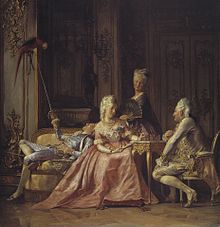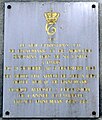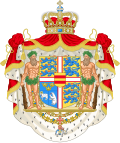Christian VII of Denmark
This article includes a list of general references, but it lacks sufficient corresponding inline citations. (October 2010) |
| Christian VII | |
|---|---|
 | |
| King of Denmark and Norway | |
| Reign | 14 January 1766 – 13 March 1808 |
| Coronation | 1 May 1767 |
| Predecessor | Frederick V |
| Successor | Frederick VI |
| Born | 29 January 1749 Christiansborg Palace, Copenhagen |
| Died | 13 March 1808 (aged 59) Rendsburg |
| Burial | |
| Consort | Caroline Matilda of Wales |
| Issue | Frederik VI of Denmark Louise Auguste, Duchess of Augustenborg |
| House | Oldenburg |
| Father | Frederik V of Denmark |
| Mother | Louise of Great Britain |
| Religion | Lutheranism |
Christian VII (Template:Lang-da; 29 January 1749 – 13 March 1808) was an Oldenburg monarch who ruled as King of Denmark and Norway and Duke of Schleswig and Holstein from 1766 until his death. He was the son of King Frederick V and his first consort Louise, daughter of King George II of Great Britain.
Christian VII's reign was marked by mental illness which affected government decisions, and for most of his reign Christian was only nominally king. His royal advisers differed depending on who won power struggles around the throne. In the late 1760s, he became submissive to the progressive and radical thinker Johann Friedrich Struensee, his personal physician, who rose steadily in power to a "de facto" regent of the country, where he introduced widespread progressive reforms.
Between 1772 and 1784, Denmark was ruled by Christian's stepmother Queen Dowager Juliane Marie, his physically disabled half-brother Frederick and the Danish politician Ove Høegh-Guldberg. From 14 April 1784 until Christian VII's death in 1808 it was his son, later Crown Prince Frederick, who unofficialy acted as Crown Prince Regent. This regency was marked by liberal and agricultural reforms, but also by the beginning disasters of the Napoleonic Wars.
For his motto he chose: "Gloria ex amore patriae" ("glory through love of the fatherland").
Early life

Christian was born in the early hours of the morning on 29 January 1749 in the Queen's Bedchamber at Christiansborg Palace, the Royal residence in Copenhagen. He was the son of King Frederick V of Denmark and Queen Louise, a daughter of George II of Great Britain. He was baptised a few hours later the same day. His godparents were King Frederick V (his father), Queen Dowager Sophie Magdalene (his paternal grandmother), Princess Louise (his aunt) and Princess Charlotte Amalie (his great-aunt).[1]
A former heir to the throne, also named Christian, had died in infancy in 1747, therefore great expectations were formed amid the birth of the new heir in 1749. Christoph Willibald Gluck, who was conductor for King Frederick V's opera troupe in Copenhagen between the years 1748-49, composed the scene La Contesa dei Numi (the contention of the gods), where the Olympian Gods gather at the banks of the Great Belt and discuss who in particular should protect the new prince.[2]

His mother Queen Louise died , just 27 years old, in 1751, two years after his birth. The following year his father remarried to Juliane Marie of Brunswick-Wolfenbüttel.
All earlier accounts agree that he had a winning personality and considerable talent, but he was poorly educated, systematically terrorized by a brutal governor, Detlev Count Reventlow, and hopelessly debauched by corrupt pages. He seems to have been intelligent and certainly had periods of clarity, but suffered from severe emotional problems, possibly schizophrenia as argued in doctor Viggo Christiansen's book Christian VII's mental illness (1906). Recent[when?] historians have, however, refrained from making a diagnosis.
Reign
After a longer period of infirmity, Frederick V died in the early hours of the morning on 14 January 1766, just 42 years old. Later the same day, Christian was proclaimed king from the balcony of Christiansborg Palace, just weeks before his 17th birthday.
Marriage

The young King was betrothed to his fifteen year old cousin Princess Caroline Matilda of Wales (known in Denmark as Queen Caroline Mathilde), a sister of Great Britain's King George III, who was anxious about the marriage but not fully aware that the bridegroom was mentally ill. The dynastic marriage took place at Christiansborg Palace on 8 November 1766, the same year as the groom's coronation.
After his marriage, he abandoned himself to the worst excesses, especially sexual promiscuity. In 1767, he entered in to a relationship with the courtesan Støvlet-Cathrine. He publicly declared that he could not love Caroline Mathilde, because it was "unfashionable to love one's wife". He ultimately sank into a condition of mental stupor. Symptoms during this time included paranoia, self-mutilation and hallucinations.
Struensee
He became submissive to the progressive and radical thinker Johann Friedrich Struensee, his personal physician, who rose steadily in power in the late 1760s, to a "de facto" regent of the country, where he introduced widespread progressive reforms. Struensee was a protégé of an Enlightenment circle of aristocrats that had been rejected from the court in Copenhagen. He was a skilled doctor, and having somewhat restored the king's health while visiting the Schleswig-Holstein area, he gained the king's affection. He was retained as travelling physician ("Livmedikus hos Kong Christian VII") on 5 April 1768, and accompanied the entourage on the King’s foreign tour to Paris and London via Hannover from 6 May 1768 to 12 January 1769. He was given the title of State Councilor ("etatsråd") on 12 May 1768, barely a week after leaving Altona. The neglected and lonely Caroline Mathilde drifted into an affair with Struensee.
Divorce
In 1772, the king's marriage with Caroline Mathilde was dissolved by divorce. Struensee, following a deluge of modernising and emancipating reforms, was arrested and executed the same year. Christian signed Struensee's arrest and execution warrant with indifference under pressure from his stepmother Queen Dowager Juliane Marie, who had led the movement to have the marriage ended. Caroline Mathilde, retaining her title but not her children, eventually left Denmark in exile and passed her remaining days at Celle Castle in her brother's German territory, the Electorate of Hanover. She died there of scarlet fever on 11 May 1775, at the age of 23.
Christian's marriage with Caroline Mathilde produced two children: the future Frederick VI and Princess Louise Auguste. However, it is widely believed that Louise was the daughter of Struensee—portrait comparisons tend to support this hypothesis.
Later life

Christian was only nominally king from 1772 onwards. Between 1772 and 1784, Denmark was ruled by Christian's stepmother Queen Dowager Juliane Marie, his physically disabled half-brother Frederick and the Danish politician Ove Høegh-Guldberg. From 1784 onwards, his son Frederick VI ruled permanently as a prince regent. This regency was marked by liberal and agricultural reforms, but also by the beginning of the disasters of the Napoleonic Wars.
Death and succession

Christian died at age 59 of a stroke on 13 March 1808 in Rendsburg, Schleswig. Rumors began that the stroke was caused by fright at the sight of Spanish auxiliaries, which he took to be hostile, but Ulrik Langen, in his biography of the king, did not indicate that there was any external cause.[3]
He was buried in Roskilde Cathedral and was succeeded by his son Frederick VI.
Legacy
Contribution to science
In 1769 Christian VII of Denmark invited the Hungarian astronomer Miksa Hell (Maximilian Hell) to Vardø. He observed the transit of Venus, and his calculations gave the most precise calculation of the Earth–Sun distance to that date (approx. 151 million kilometres).
His companion János Sajnovics explored the affinity among the languages of the Sami, Finnish and Hungarian peoples.[4][5][6]
Cultural depictions

Christian VII, the story of his marriage, and his wife's affair with Struensee has featured in many examples of popular culture:
- The Dictator - a 1935 British film, in which Christian VII was played by Emlyn Williams. The film depicts his relationship with Caroline Mathilde, who is played by Madeleine Carroll.
- Herrscher ohne Krone - a 1953 German film.
- Caroline Mathilde - a 1991 two-act ballet staged by the Royal Danish Ballet and choreographed by Flemming Flindt to music by Sir Peter Maxwell Davies.
- The Visit of the Royal Physician (Template:Lang-sv) - a 1999 novel by Per Olov Enquist.
- The Visit of the Royal Physician (Template:Lang-da) - a 2008 opera staged by the Royal Danish Opera and composed by Bo Holten to a libretto based on Enquist's 1999 novel.
- A Royal Affair (Template:Lang-da) - a 2012 Academy Award-nominated film in which King Christian is played by Mikkel Følsgaard.
Titles and styles
- 29 January 1749 – 14 January 1766: His Royal Highness The Crown Prince
- 14 January 1766 – 13 March 1808: His Majesty The King
The full title of Christian VII was: By the Grace of God, King of Denmark and Norway, the Wends and the Goths, Duke of Schleswig, Holstein, Stormarn and Dithmarschen, Count of Oldenburg and Delmenhorst. Oldenburg was elevated to a duchy during his reign, and the style was changed accordingly: By the Grace of God, King of Denmark and Norway, the Wends and the Goths, Duke of Schleswig, Holstein, Stormarn, Dithmarschen and Oldenburg. This style was used until his son, Frederick VI, who lost control over Norway by the 1814 Treaty of Kiel.
-
Christian VII's coat-of-arms, still showing the Norwegian Lion
-
Commemorative plaque with Christian VII's monogram due his stay at 33, rue Jacob in Paris from 21 October to 9 December 1768
Ancestry
External links
Literature
- Alenius, Marianne (ed.): Mit ubetydelige Levnets Løb. Efter Charlotte Dorothea Biehls breve. Museum Tusculanums Forlag, Copenhagen 1986
- Barz, Paul: Doktor Struensee. Bogans Forlag, Lynge, 1986
- Bech, Svend Cedergreen: Brev fra Dorothea, Politikens Forlag, Copenhagen 1975
- Blangstrup, Christian: Christian VII og Caroline Mathilde. Gyldendalske Boghandels Forlag (F. Hegel & Søn) Copenhagen 1890
- Bobé, Louis (ed.): Interiører fra Kong Christian VIIs Hof. Efter Charlotte Dorothea Biehls breve. J. L. Lybecker Forlag, Copenhagen 1919
- Christiansen, Viggo: Christian den VII's sindssygdom. Odense Universitetsforlag, 1978
- Dehn-Nielsen, Henning: Christian 7. Den gale konge. Sesam, Copenhagen, 2000
- Den Store Danske encyclopedia, Danmarks Nationalleksikon/Gyldendal, Copenhagen, 1996
- Enquist, Per Olov: Livläkarens besök. Norstedts Förlag, Stockholm, 1999
- Fjelstrup, August: Skilsmisseprocessen imellem Kong Kristian den syvende og Dronning Karoline Matilde. Strubes Forlag, 1968.
- Hansen, Norman Hall: Caroline Mathilde. Ejnar Munksgaards Forlag, Copenhagen 1947
- Holm, Sven: Struensee var her, Danmarks Radio, Copenhagen, 1981
- Laing R. D. og Esterson A.: Familieliv. Rhodos, Copenhagen 1974
- Lassen, N. et al (Red.) Tidsskrift for Retsvidenskab. Den Struensee'ske Proces. 4.årgang. Christiania, 1891
- Lauring, Palle: Historiske Portrætter. Aschehoug Dansk Forlag, Copenhagen 1960
- Reverdil, Elie Salomon François: Struensee og det danske hof 1760-1772. A. F. Høst & Søn Forlag, Copenhagen 1917
- Salmonsens Konversations Leksikon, Schultz, Copenhagen, 1926
- Steenstrup, Joh. et al. (Red): Danmarks Riges historie. Det Nordiske Forlag, Copenhagen
- Zernikow, D. von Der Lyhe: Støvlet-Kathrine: Fortælling fra Christian VIIs tid. Copenhagen, 1903
References
- ^ "Kongelig fødsel og dåb - om kirkebøgerne - fra Dansk Historisk Fællesråd" (in Danish). historie-online.dk. Retrieved 18 February 2013.
- ^ "Charlottenborg - et stop på din musikalske byvandring gennem København" (in Danish). The Royal Danish Library. Retrieved 16 February 2013.
- ^ Ulrik Langen, 2008, s. 485ff
- ^ Kragh, Helge (2008). The Moon that Wasn't: The Saga of Venus' Spurious Satellite. Springer. p. 199. ISBN 3-7643-8908-7, ISBN 978-3-7643-8908-6.
- ^ Jacek Juliusz Jadacki, Witold Strawiński, Jerzy Pelc. In the World of Signs: Essays in Honour of Professor Jerzy Pelc, Rodopi: 1998, p. 459. ISBN 90-420-0389-8, ISBN 978-90-420-0389-7.
- ^ Mikko Korhonen. Finno-Ugrian Language Studies in Finland, 1828–1918, Societas Scientiarum Fennica, 1986. p. 226. ISBN 951-653-135-0, ISBN 978-951-653-135-2.
- Use dmy dates from October 2010
- 1749 births
- 1808 deaths
- 18th-century monarchs in Europe
- 19th-century monarchs in Europe
- Burials at Roskilde Cathedral
- Danish monarchs
- Denmark–Norway
- Dukes of Holstein
- Dukes of Schleswig
- House of Oldenburg
- Norwegian monarchs
- People from Copenhagen
- Protestant monarchs
- Royal Fellows of the Royal Society



